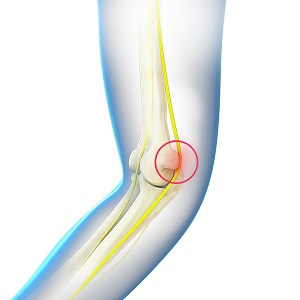
What is Ulnar Nerve Neuritis?
Ulnar nerve neuritis, also known as ulnar nerve entrapment or cubital tunnel syndrome, is a condition in which the ulnar nerve becomes irritated and inflamed due to constant pressure on it, leading to various symptoms. The nerve can become compressed at several places along its length, such as at the collarbone or wrist; but the most common area of compression is an area of the elbow called the cubital tunnel.
The ulnar nerve travels down the back of the elbow behind a bony bump called the medial epicondyle, and through a passageway called the cubital tunnel. The cubital tunnel is a narrow passageway on the inside of the elbow formed by bone, muscle, and ligaments, with the ulnar nerve passing through its center.
If left untreated, ulnar nerve neuritis can lead to permanent nerve damage in the hand, as well as other conditions such as muscle atrophy (decrease in muscle mass).
Anatomy of the Ulnar Nerve
The ulnar nerve is one of the three major nerves in the arm. It begins in the neck region and passes via the shoulder down the arm into the wrist and fingers. It provides sensation to the forearm and 4th and 5th fingers of the hands. It also regulates most of the small muscles in the hand that assist with fine movement, plus some of the larger muscles in the forearm that assist with grip.
Causes of Ulnar Nerve Neuritis
Some common causes of ulnar nerve neuritis include:
- Injury to the elbow, such as fractures, dislocations, or a direct blow, can cause tissue swelling which can compress the ulnar nerve within the cubital tunnel.
- Individuals who perform repetitive elbow flexion movements at work or play are believed to be at higher risk for developing ulnar nerve neuritis.
- Repeated bending and straightening the elbow can irritate and inflame the ulnar nerve.
- Leaning on the elbow for extended periods of time, such as when working at a desk, can also cause ulnar nerve irritation.
- Bone spurs, ganglion cysts, or tumors can form in the cubital tunnel, leading to pressure and irritation of the ulnar nerve.
Signs and Symptoms of Ulnar Nerve Neuritis
Signs and symptoms of ulnar nerve neuritis usually occur gradually, progressing to the point of requiring medical attention. Commonly reported symptoms associated with ulnar nerve neuritis include intermittent numbness, tingling, and pain to the little finger, ring finger, and the inside of the hand. These symptoms occur more frequently at night, when the elbow is bent or rested upon for prolonged periods.
Diagnosis of Ulnar Nerve Neuritis
Your doctor will assess your symptoms and take your medical history. Specific movements may be performed to physically examine your muscle strength. Gentle tapping at the medial epicondyle region may be performed to observe if you feel sharp sensations in your ring finger and little finger. Imaging studies (X-ray, MRI, CT-scan) may be ordered. Nerve tests including electromyography and nerve conduction studies may be ordered to confirm the diagnosis.
Treatment of Ulnar Nerve Neuritis
Your physician will initially recommend conservative treatment options to treat the ulnar nerve neuritis symptoms unless muscle atrophy or nerve damage is present. Conservative treatment options may include:
- Non-steroidal anti-inflammatory drugs (NSAIDs) to manage swelling and pain.
- Wearing a brace or splint at night while sleeping to keep the elbow in a straight position. You can also wrap the arm loosely with a towel and apply tape to hold it in place.
- Avoiding pressure to the elbow by not leaning on it. Elbow pads may be worn to decrease pressure when working at a desk.
- Physical therapy exercises for strengthening the elbow and arm muscles to enhance your flexibility, range of motion, and strength.
If conservative treatment options fail to resolve the condition or if muscle atrophy or severe nerve compression is present, your surgeon may recommend a surgical procedure to treat ulnar nerve neuritis.
The goal of the surgery is to reduce the pressure on the ulnar nerve by providing more space for the nerve to move freely and to increase blood flow for the inflamed ulnar nerve to heal. Some of the common surgeries performed to treat ulnar nerve neuritis include:
- Medial epicondylectomy: This surgery involves removing a part of the medial epicondyle, the bony bump on the inside of the elbow, and enabling the ulnar nerve to glide smoothly when the elbow is flexed and straightened.
- Ulnar nerve transposition: This surgery involves creating a new tunnel in front of the medial epicondyle and transposing (moving) the ulnar nerve to the new tunnel. This transposition prevents nerve entrapment at the bony ridge and stretching of the nerve when the elbow is bent.
- Cubital tunnel release/ulnar nerve release: This is a procedure to increase the size of the cubital tunnel by trimming and separating the overlying ligament to decrease the pressure on the ulnar nerve and provide more space for the nerve to move freely at the elbow.
- If the ulnar nerve is compressed at the wrist region, your surgeon makes an incision there to access the ulnar nerve and perform nerve decompression in a similar manner.
Your surgeon will decide which surgery is best for you depending on your condition.










